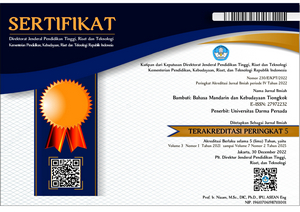ACCULTURATION IN GOD'S BIRTHDAY CEREMONY KELENTENG SHIA DJIN KONG, JONGGOL
AKULTURASI DALAM UPACARA ULANG TAHUN DEWA DI KELENTENG SHIA DJIN KONG, JONGGOL
Abstract
This paper discussed the acculturation of Chinese and Sundanese culture in a ceremony at the Shia Djin Kong temple, Jonggol. On the right side of the temple there is a special room for the cult of Jonggol's ancestors, namely Embah Jago, Embah Sabin, Embah Surkat, Embah Jagakarsa, and Embah Nagawulung. In that room there are also many heirloom objects, such as keris, spears, lafadz Allah, and swords. Acculturation between Sundanese culture and Chinese culture can be seen at the birthday ceremony of the god Shia Djin Kong, which is the similarity between local culture and Chinese culture, in ancestor worship. The research method used in this writing is a qualitative research method, data collection techniques in this writing are participant observation, observation, and interviews to the temple officer, and people who come to pray both during the god's birthday ceremony and on ordinary days.

This work is licensed under a Lisensi Creative Commons Atribusi 4.0 Internasional.
Authors who publish with this journal agree to the following terms:
- Authors retain copyright and grant the journal right of first publication with the work simultaneously licensed under a Lisensi Creative Commons Atribusi 4.0 Internasional that allows others to share the work with an acknowledgment of the work's authorship and initial publication in this journal.
- Authors are able to enter into separate, additional contractual arrangements for the non-exclusive distribution of the journal's published version of the work (e.g., post it to an institutional repository or publish it in a book), with an acknowledgment of its initial publication in this journal.
- Authors are permitted and encouraged to post their work online (e.g., in institutional repositories or on their website) prior to and during the submission process, as it can lead to productive exchanges, as well as earlier and greater citation of published work (See The Effect of Open Access).









